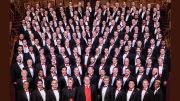By: Chris Azzopardi/Special for TRT–
A child imagines life outside reality by creating a wild, monster-inhabited world of escapism in Pan’s Labyrinth, a stylistic fantasy-art film released in 2006 from Guillermo del Toro. That world, or at least a version of it, is very familiar to Mike Ruiz.
As a kid, growing up as one of few ethnic people in Quebec, he envisioned an alternate reality that transcended his drab real life. Little did he know that years later he’d be implementing it into real life: he’s famous for his celebrity photographs, capturing the who’s-who of Hollywood in another light.
He’s also part of another reality – reality TV. Aside from Logo’s The A-List: New York, which he left last year after two seasons of the tawdry show, he’s also been seen on RuPaul’s Drag Race and America’s Next Top Model. With Pretty Masculine, the first in a series of books released late last year, he’s focusing on photography, which includes an upcoming shoot with Martha Wash – and a storm of beefcakes – to celebrate the 30th anniversary of “It’s Raining Men.”
Ruiz phoned us recently to talk about his break from reality TV (and to defend A-List), his new series of books, and how childhood transcendence inspired his photography career.
Chris Azzopardi: How are you able to balance a partner, photography, TV and charity work – all the while maintaining the muscles?
Mike Ruiz: I think it’s just my perception. I chose to perceive things differently, so my life just seems so much more manageable and calmer so far this year than it was in 2011.
Q: Not doing reality TV probably helps?
A: That’s probably the main reason. (Laughs) It’s not so much that it occupied a lot of time; it occupied a lot of my mental energy.
Q: Wait. Reality TV?
A: (Laughs) Imagine that!
Q: What about it?
A: I don’t know. Honestly, I can’t put my finger on it. It’s just a lot of effort and a lot of work. You have all these hopes and expectations for the outcome, and you’re kind of white knuckling it because you have no control over anything, so you just do your best and hope for the best. It’s just too taxing for too little pay off.
Q: Why did you do The A-List: New York in the first place?
A: I did A-List for very specific reasons, and it was not to hang my dirty laundry out. I did it because I wanted to be more visible in the community so I could do positive things in the community. You never know – those guys on Jersey Shore probably never thought they’d be making $7, $8 million a year; there’s always the hope that it’s going to become this pop culture phenomenon and you’re going to ride the wave and it’ll be great, but fundamentally, I just wanted to do something responsible.
If my goal was to become a Jersey Shore kind of character, I would’ve been way more reckless on TV. I feel like I conducted myself in a very responsible way. That was my goal, and I do it in life, as well. It’s important for me to put my best foot forward to set a good example, so I’m certainly not going to go on TV and get wasted and puke all over my other cast members. (Laughs)
Q: In general, do you think the show gives gay people a bad name?
A: It shouldn’t give anybody a bad name. It’s not meant to be a representation of anybody. It’s five or six people that they cast very specifically to make it an entertaining show, and for all intents and purposes it was very entertaining to a pretty big audience. It wasn’t meant to be responsible; it wasn’t meant to portray anybody in any kind of light. Most things on TV aren’t meant to be responsible. It was never fair to hold a few random people accountable for a whole community.
If you were to take a poll, a negligible percentage even gave a crap. But sadly, the 10 people who did were vocal enough about it to make it seem like there was this blanket of negativity over this show when that’s really unrealistic.
Q: How much of these reality TV shows are actually reality?
A: These days, honestly, none of it is reality. I’ve done everybody’s show, and I love them, but it’s no secret. I’ve worked with Kim Kardashian and Khloe Kardashian and I’m like, “This is so put on. None of this stuff is real.” It’s all fabricated for TV. Something may happen but then, from a producer’s standpoint, they think, “How am I gonna spin it into a whole storyline?” That’s when the artificiality comes in. So reality TV is not real.
Q: How did the idea for the book Pretty Masculine come to you?
A: I don’t typically shoot men a lot and being a gay man I was thinking, “Why haven’t I shot men much?” I wanted to figure out a way to do something that wasn’t gratuitously homoerotic – that stuff doesn’t appeal to me. Because of my whole outlook on life, and everything being very fantasy-driven with me, I wanted to carry that over into this book and do something super stylized and take hyper-masculine men and soften them up a bit and portray them out of context. It just grew into this book to buck the stereotype of what people think masculinity is.
I’m working on a second edition that’s gone into a whole other direction; it’s a little bit of that and it’s also just about pop art and using these men as canvases for other artists. It’s become this huge collaborative thing between me and all these body painters. Some of them are spectacular. The book, called Pretty Masculine Too, is going to be interactive; there will be a digital version for the iPad, and there will be video footage showing the making of it and some of the makeup application from beginning to end. I’m really excited about this second reincarnation.
Q: This idea of an alternate reality has always interested you, right?
A: I was always a sci-fi geek and before that, I loved musicals from the ’40s and ’50s where everything was Technicolor and everyone’s hair was perfect. That’s kind of where I needed to live when I was a kid, because my childhood was very gray and dingy. It started out as just as a very rich fantasy life as a kid, but then it eventually manifested into a tactile thing; I actually had to start creating this for myself.
You know, I used to see things on TV – we had three channels because we didn’t have cable back then – and every once in a while we’d get a news clip from Studio 54 and that would fuel me. I just needed to see a 30-second clip from Studio 54 and I would have months of daydreams fabricated around it. (Laughs).
Q: When did you start applying that to photography?
A: I got the camera when I was around 30, and that’s when I started my photography career – but I started implementing the idea of creating a more beautiful reality around me much before; as soon as I was able to leave home is when it kind of happened. I was a model and my childhood was very tumultuous, so I always had to create a very serene, calm sort of vibe around me, and I was pretty successful at creating, on the surface anyway, this much happier and calmer environment.
It just started as simple as my environment. I’d make my apartment, wherever I lived, really beautiful and then I started modeling, traveling and getting the inkling to get creative and expressive. When I got that camera, it became the spigot for everything that I had to say; it was a way for me to create this alternate reality in a real, tangible way.
Q: How do you come up with the concepts for your celebrity subjects?
A: It’s such a weird, organic thing and it’s so second nature, so I don’t know. There’s always something about a person that I feel, however I decide to portray them, is not completely alien to them; it’s something that I think resides in them but hasn’t been brought to the surface yet. I don’t do it for shock and awe, and I don’t do it to make them uncomfortable. It’s all aspiration. I want to create a different and perfected version of themselves. I’m not interested in capturing the reality of people, like a lifestyle sitting-on-the-couch-drinking-coffee thing. I like to create this impression that you’re looking at a painting. It’s a perfected version of reality.
Q: And that all goes back to your childhood, right?
A: It all goes back to that. Fortunately, I had that to rely on instead of drugs and alcohol, but I struggled emotionally. It wasn’t easy. I left home and everything wasn’t hunky-dory. I had a lot of stuff to work through. I was a pretty tortured young adult, and then I just kind of figured some stuff out – and then I figured out how to figure out more stuff – and it’s been smooth sailing for the past six years.
Q: You’ve shot Kathy Griffin, Ricky Martin and Zac Efron, to name just a few. Who’s been particularly memorable?
A: When I work with somebody it’s like a catharsis. I work with them and get everything out and move on from that. I don’t stay in one place; once something is done, I’m onto the next thing, so I don’t really have favorites. Basically whoever the last person I worked with is my favorite. I just worked with Katharine McPhee and Megan Hilty, who’s such a sweetheart. I jacked her up and I did my thing and she looks so spectacularly beautiful in the shots that we did. I’m really proud of that shoot. It was simple because it was for a magazine’s June cover, so I couldn’t go too crazy, but they allowed me to take it up a few notches.
Q: So your body – how do you maintain that?
A: Photoshop. (Laughs) It’s all part of my childhood thing. I was a heavy, unhealthy kid and I had anemia and other health problems – not major but minor – and I was just tired of it. When I was a kid I used to fantasize about hot, hunky guys, so I thought the only way I’m going to be in that arena is if I take care of myself. And it started out as that, that was my motivation, but then it grew into just feeling better. And I continue to do it.
Q: How does it feel to be engaged? And what’re your wedding plans?
A: Being engaged, I don’t know. I’m connected to Martin emotionally and spiritually in a way that transcends the need to have a ring or anything like that. The tradition of it doesn’t really mean anything to me, but the fact that we are afforded that right in the state of New York, I just wanted to exercise it mostly from a legal standpoint so we’re both protected under the law. But I love Martin. He’s everything to me. He’s a sweet, kind, gentle, compassionate man. We still fall asleep looking into each other’s eyes every night. It’s hokey, but it’s really wonderful being in the same room with him.
Q: You donated all the proceeds from the first 500 copies of Pretty Masculine to Gay Men’s Health Crisis, and you’ve supported many other charities. Why is charity work so important to you?
A: I always knew the moment I had the capacity to do something I wanted to be helpful in the community. Most of my adult life was spent trying to get my shit together, but I always told myself, “The minute you have a platform and you’re capable and you’re financially secure, you’re going to do something beyond you, something that’s not completely self-serving.” So I’ve always had that in the back of my mind, and in the past few years with my visibility growing, it’s just given me a platform to do something.








